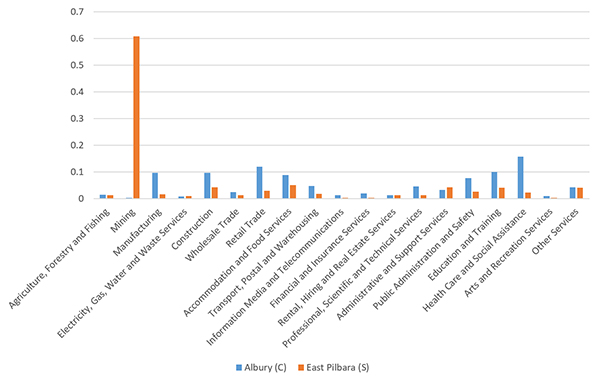Definition of The Measures
Diversification index
To measure how economically-diverse a region is, we use the Hachman index of economic diversification. It shows how diverse a region’s economic structure is relative to that of the Australian economy.
Values closer to one mean that the region’s economic structure is very diverse. Values closer to zero mean that the region is dominated by just one or two industries.
As an example, Albury in NSW has one of the most diverse economies found in a Local government area with a diversification index of 0.93. This is due to employment spread out over a range of industries. At the other end of the spectrum is East Pilbara (index of 0.04), where mining is the dominant industry. To illustrate this, the graph below shows the spread of workers across many industries in Albury and East Pilbara.

Figure 1: Diversification – the two extremes
Number of years
This measure is the number of years it would take, with a typical income, to pay off a median-priced house in that specific LGA.
To obtain this number, the median house price of an LGA is divided by 28% of the average income for the same region. 28% is a threshold typically used by banks as a maximum amount of income that should be committed to a mortgage. Our calculations do not include any interest.
National Park index
This is a simple measure to show the proximity of National Parks to where people live in a region. In the graph to the right of the map, it is represented as an index. A rating closer to one shows closer (better) proximity – the value in kilometres is also available in the popup information on the map.
Coastal index
This is a similar measure that shows the proximity of the coast to where people live in a region. In the graph to the right of the map, it is also represented as an index. A rating closer to one shows closer (better) proximity – the value in kilometres is also available in the popup information on the map.